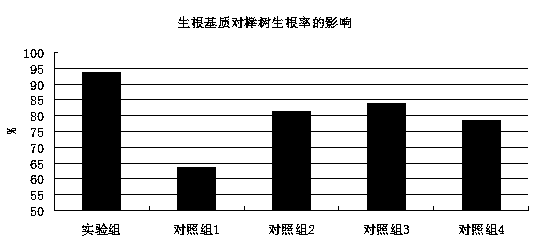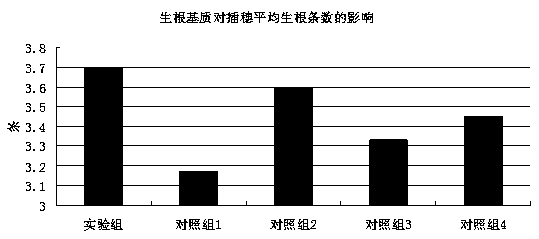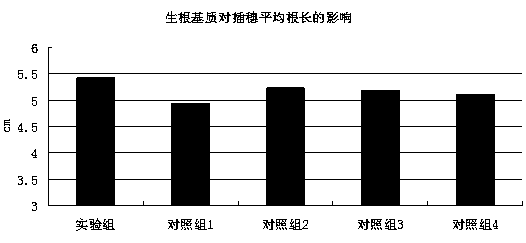Process for breeding zelkova schneideriana by hardwood cutting
A hard-branch cutting and process technology, which is applied in the field of using hard-branch cuttings to propagate beech trees, can solve problems such as rooting rate only reaching 50%, poor effect of substrate ventilation and water retention, plant pathogenic bacteria infecting roots, etc. The cutting method is simple and feasible, and the effect of promoting the rooting of cuttings
- Summary
- Abstract
- Description
- Claims
- Application Information
AI Technical Summary
Problems solved by technology
Method used
Image
Examples
Embodiment 1
[0035] The technology of propagating beech with hardwood cuttings, it comprises the steps:
[0036] Taking beech as the research object, the cutting time was March 25, and the thick fork branches and side branches from the 5-year-old mother tree were selected as cuttings. The cuttings were cut with a length of 12cm and a thickness of 0.5-1.0cm. There are more than 2 strong and full axillary buds, and the lower cut is trimmed at a 45-degree oblique cut. Soak in phytohormone (200mg / L IBA+200mg / L 6-BA) for 9 hours; then insert into the rooting matrix, the depth of inserting into the rooting matrix is half the length of the cuttings, and water thoroughly; the inserting bed is set in the greenhouse, The temperature is 25-30°C, the light time is 6h, and the light intensity is 10000Lux. One month after cutting, move to the outdoor hardening for two months to check the rooting situation. The outdoor hardening uses a sunshade net with a shading rate of 50%, and the temperature is ke...
Embodiment 2
[0044] The technology of propagating beech with hardwood cuttings, it comprises the steps:
[0045] Taking beech as the research object, the cuttage time was April 5th, and the thick fork branches and side branches from the 5-year-old mother tree were selected as cuttings. The cuttings were cut with a length of 15cm and a thickness of 0.5-1.0cm. There are more than 2 strong and full axillary buds, and the lower cut is trimmed at a 45-degree oblique cut. Soak in phytohormone (300mg / L IBA+300mg / L 6-BA) for 6 hours; then insert into the rooting matrix, the depth of inserting into the rooting matrix is half the length of the cuttings, water thoroughly; the inserting bed is set in the greenhouse, The temperature is 25-30°C, the light time is 6-8h, and the light intensity is 8000-10000Lux. One month after cutting, move to the outdoor hardening for two months to check the rooting situation. The outdoor hardening uses a sunshade net with a shading rate of 50%, and the temperature i...
Embodiment 3
[0053] The rooting situation of beech hardwood cuttings of the present invention:
[0054] Different groups were set up to detect the influence of different rooting substrates on rooting.
[0055] Experimental group: the rooting matrix prepared in embodiment 1;
[0056] Matched group 1: 20 parts of vermiculite, 10 parts of perlite, 20 parts of peat soil, all the other are the same as embodiment 1;
[0057] Control group 2: 3 parts of biological bacteria agent, 10 parts of perlite, 20 parts of peat soil;
[0058] Control group 3: 3 parts of biological bacteria agent, 20 parts of vermiculite, 10 parts of perlite;
[0059] Control group 4: 3 parts of biological bacteria agent, 10 parts of perlite, 20 parts of peat soil;
[0060] The cutting process of each group is the same as in Example 1, and the number of cuttings in each group is 200. For the cutting conditions of each group substrate, see Figure 1-3 As shown, compared with the control group 1-4, the cutting rooting effe...
PUM
 Login to View More
Login to View More Abstract
Description
Claims
Application Information
 Login to View More
Login to View More - R&D
- Intellectual Property
- Life Sciences
- Materials
- Tech Scout
- Unparalleled Data Quality
- Higher Quality Content
- 60% Fewer Hallucinations
Browse by: Latest US Patents, China's latest patents, Technical Efficacy Thesaurus, Application Domain, Technology Topic, Popular Technical Reports.
© 2025 PatSnap. All rights reserved.Legal|Privacy policy|Modern Slavery Act Transparency Statement|Sitemap|About US| Contact US: help@patsnap.com



